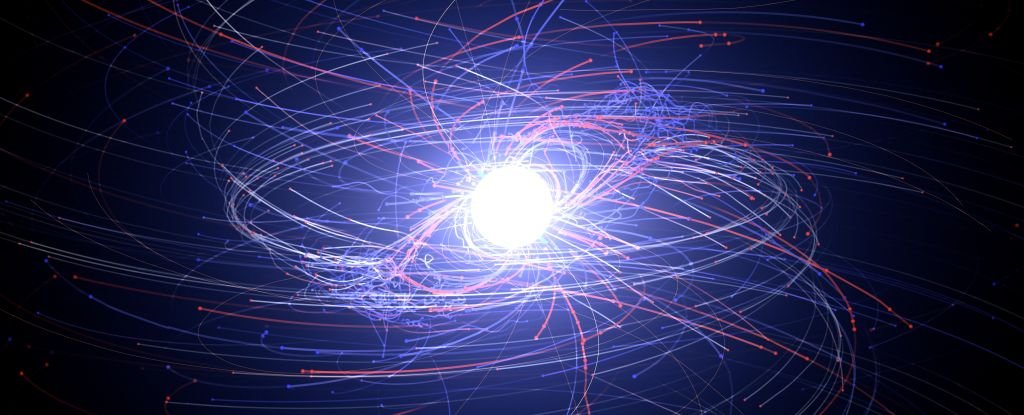Products You May Like
One of the most extreme stars in the Milky Way just got even more wack.
Scientists have measured the mass of a neutron star named PSR J0952-0607, and found that it’s the most massive neutron star discovered yet, clocking in at a whopping 2.35 times the mass of the Sun.
If true, this is very close to the theorized upper mass limit of around 2.3 solar masses for neutron stars, representing an excellent laboratory for studying these ultra-dense stars at what we think is the brink of collapse, in the hope of better understanding the weird quantum state of the matter of which they are made.
“We know roughly how matter behaves at nuclear densities, like in the nucleus of a uranium atom,” said astrophysicist Alex Filippenko of the University of California, Berkeley.
“A neutron star is like one giant nucleus, but when you have one-and-a-half solar masses of this stuff, which is about 500,000 Earth masses of nuclei all clinging together, it’s not at all clear how they will behave.”
Neutron stars are the collapsed cores of massive stars that were between around 8 and 30 times the mass of the Sun, before they went supernova and blew most of their mass off into space.
These cores, tending to be around 1.5 times the mass of the Sun, are among the densest objects in the Universe; the only thing denser is a black hole.
Their mass is packed into a sphere just 20 kilometers (12 miles) or so across; at that density, protons and electrons can combine into neutrons. The only thing keeping this ball of neutrons from collapsing into a black hole is the force it would take for them to occupy the same quantum states, described as degeneracy pressure.
In some ways this means neutron stars behave like massive atomic nuclei. But what happens at this tipping point, where neutrons form exotic structures or blur into a soup of smaller particles, is hard to say.
PSR J0952-0607 was already one of the most interesting neutron stars in the Milky Way. It’s what is known as a pulsar – a neutron star that is spinning very fast, with jets of radiation emitting from the poles. As the star spins, these poles sweep past the observer (us) in the manner of a cosmic lighthouse so that the star appears to pulse.
These stars can be insanely fast, their rotation rate on millisecond scales. PSR J0952-0607 is the second-fastest pulsar in the Milky Way, rotating a mind-blowing 707 times per second. (The fastest is only slightly faster, with a rotation rate of 716 times per second.)
It’s also what is known as a “black widow” pulsar. The star is in a close orbit with a binary companion – so close that its immense gravitational field pulls material from the companion star. This material forms an accretion disk that whirls around and feeds into the neutron star, a bit like water swirling around a drain. Angular momentum from the accretion disk is transferred to the star, causing its spin rate to increase.
A team led by astrophysicist Roger Romani of Stanford University wanted to understand better how PSR J0952-0607 fit into the timeline of this process. The binary companion star is tiny, less than 10 percent of the mass of the Sun. The research team made careful studies of the system and its orbit and used that information to obtain a new, precise measurement for the pulsar.
Their calculations returned a result of 2.35 times the mass of the Sun, give or take 0.17 solar masses. Assuming a standard neutron star starting mass of around 1.4 times the mass of the Sun, that means that PSR J0952-0607 has slurped up to an entire Sun’s worth of matter from its binary companion. This, the team says, is really important information to have about neutron stars.
“This provides some of the strongest constraints on the property of matter at several times the density seen in atomic nuclei. Indeed, many otherwise popular models of dense-matter physics are excluded by this result,” Romani explained.
“A high maximum mass for neutron stars suggests that it is a mixture of nuclei and their dissolved up and down quarks all the way to the core. This excludes many proposed states of matter, especially those with exotic interior composition.”
The binary also shows a mechanism whereby isolated pulsars, without binary companions, can have millisecond rotation rates. J0952-0607’s companion is almost gone; once it’s entirely devoured, the pulsar (if it’s not tipped over the upper mass limit and collapses further into a black hole) will retain its insanely fast rotation speed for quite some time.
And it will be alone, just like those all the other isolated millisecond pulsars.
“As the companion star evolves and starts becoming a red giant, material spills over to the neutron star, and that spins up the neutron star. By spinning up, it now becomes incredibly energized, and a wind of particles starts coming out from the neutron star. That wind then hits the donor star and starts stripping material off, and over time, the donor star’s mass decreases to that of a planet, and if even more time passes, it disappears altogether,” Filippenko said.
“So, that’s how lone millisecond pulsars could be formed. They weren’t all alone to begin with – they had to be in a binary pair – but they gradually evaporated away their companions, and now they’re solitary.”
The research has been published in The Astrophysical Journal Letters.
